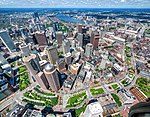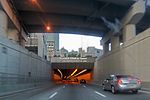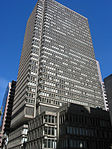One International Place
Commons category link is locally definedFinancial District, BostonJohn Burgee buildingsOffice buildings completed in 1987Philip Johnson buildings ... and 1 more
Skyscraper office buildings in Boston

One International Place is a Postmodern skyscraper in the Financial District of Boston, Massachusetts. Built in 1987, and designed by Johnson/Burgee Architects – whose principals are Philip Johnson and John Burgee – it is Boston's 7th-tallest building, standing 600 feet (183 m) tall and housing 46 floors. The building is very prominent in the city's skyline, particularly when viewed from Boston Harbor. The building has three separate elements. These consist of the tower itself, as well as two smaller components (27- and 19-stories). It also is linked by a central dome and winter garden with Two International Place.
Excerpt from the Wikipedia article One International Place (License: CC BY-SA 3.0, Authors, Images).One International Place
Oliver Street, Boston Downtown Boston
Geographical coordinates (GPS) Address External links Nearby Places Show on map
Geographical coordinates (GPS)
| Latitude | Longitude |
|---|---|
| N 42.355777777778 ° | E -71.052083333333 ° |
Address
One International Place
Oliver Street 100
02110 Boston, Downtown Boston
Massachusetts, United States
Open on Google Maps









